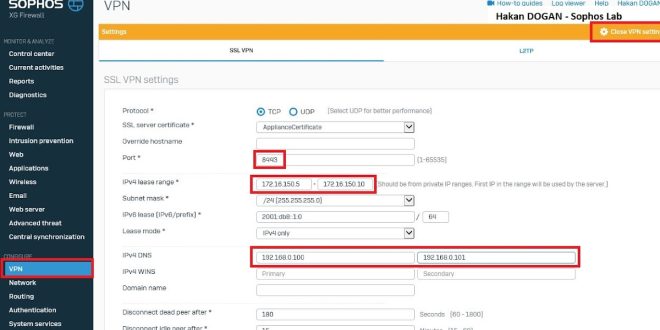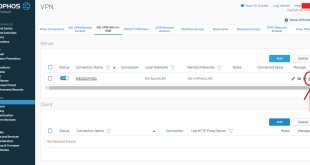Avoiding the dreaded blue screen of death is crucial for any computer user, but when it comes to using the Sophos SSL VPN client, this problem becomes even more frustrating. If you’ve experienced a blue screen while using the Sophos SSL VPN client, you’re not alone. This article will explore the causes of the blue screen issue and provide solutions to help you overcome this problem.
Table of Contents
Sophos SSL VPN Client Blue Screen Pain Points
The blue screen problem with the Sophos SSL VPN client can cause a range of issues for users. It often leads to unexpected system crashes, loss of unsaved data, and can disrupt productivity. This problem can be particularly frustrating for individuals who rely on the VPN client for remote access to company resources. To make matters worse, the blue screen issue can be challenging to diagnose and resolve, leaving users feeling helpless.
Understanding the Sophos SSL VPN Client Blue Screen
The blue screen error with the Sophos SSL VPN client is typically caused by conflicts between the VPN client software and the operating system. These conflicts can occur due to outdated or incompatible drivers, software conflicts, malware infections, or hardware issues. When these conflicts arise, they can trigger a critical system error, resulting in a blue screen crash.
Summary of Sophos SSL VPN Client Blue Screen
In summary, the Sophos SSL VPN client blue screen issue is a frustrating problem that can disrupt productivity and cause system crashes. It is typically caused by conflicts between the VPN client software and the operating system. Resolving this issue requires identifying and addressing the underlying causes of these conflicts, such as updating drivers, resolving software conflicts, and ensuring the system is free of malware.
Sophos SSL VPN Client Blue Screen – Personal Experience and Explanation
As a user of the Sophos SSL VPN client, I have encountered the dreaded blue screen error on multiple occasions. One particular experience stands out in my memory. I was working on an important project, accessing company resources through the VPN client when suddenly, my screen turned blue and my computer crashed. Not only did I lose valuable time, but I also lost unsaved data, resulting in significant setbacks.
The blue screen error was caused by an outdated driver conflicting with the VPN client software. After extensive troubleshooting and research, I discovered that updating the driver to the latest version resolved the issue. It was a frustrating experience, but it taught me the importance of keeping drivers up to date to prevent blue screen crashes.
Sophos SSL VPN Client Blue Screen – Explanation
The Sophos SSL VPN client is a virtual private network (VPN) software that allows users to securely access company resources remotely. However, due to conflicts between the VPN client software and the operating system, users may encounter the dreaded blue screen error. This error occurs when the system encounters a critical error, leading to a complete system crash.
To prevent blue screen crashes with the Sophos SSL VPN client, it is essential to keep drivers up to date, resolve software conflicts, and ensure the system is protected against malware. Regularly updating the VPN client software can also help address compatibility issues and improve overall system stability.
Sophos SSL VPN Client Blue Screen – History and Myth
The history of the Sophos SSL VPN client blue screen issue is not well-documented. However, users have reported encountering this problem since the early versions of the VPN client software. Over time, the Sophos development team has released updates and patches to address the blue screen issue and improve the overall stability of the software.
While some may refer to the blue screen issue as a myth or exaggeration, those who have experienced it firsthand understand the frustration and productivity loss it can cause. It is essential to address this issue seriously and explore solutions to prevent future occurrences.
Sophos SSL VPN Client Blue Screen – Hidden Secret
Behind the scenes, the Sophos development team works tirelessly to address the blue screen issue with their SSL VPN client. They continuously analyze crash reports, identify potential conflicts, and release updates to enhance compatibility and stability. Additionally, they collaborate with users and IT professionals to gather feedback and address specific scenarios that may trigger the blue screen error.
While the hidden secrets of the Sophos SSL VPN client blue screen issue may not be widely known, the dedication and efforts of the development team demonstrate their commitment to providing an optimal and reliable VPN experience for users.
Sophos SSL VPN Client Blue Screen – Recommendations
To avoid the blue screen issue with the Sophos SSL VPN client, it is crucial to follow these recommendations:
- Regularly update the VPN client software to the latest version.
- Keep drivers up to date to prevent conflicts with the VPN client.
- Resolve any software conflicts that may be causing the blue screen error.
- Ensure that your system is protected against malware and other security threats.
By implementing these recommendations, you can minimize the risk of encountering the blue screen issue and enjoy a stable and secure VPN connection.
Sophos SSL VPN Client Blue Screen – Explained in Detail
The Sophos SSL VPN client blue screen issue occurs when conflicts between the VPN client software and the operating system lead to a critical system error. These conflicts can be caused by outdated or incompatible drivers, software conflicts, malware infections, or hardware issues.
Updating drivers to the latest version can help address compatibility issues and reduce the risk of encountering the blue screen error. Resolving software conflicts involves identifying conflicting applications or processes and either updating or uninstalling them. Regularly scanning your system for malware and keeping security software up to date is crucial for preventing the blue screen issue caused by malicious activities.
Tips for Resolving Sophos SSL VPN Client Blue Screen
Resolving the Sophos SSL VPN client blue screen issue can be a challenging task. Here are some tips to help you overcome this problem:
- Update the VPN client software to the latest version.
- Ensure that your system meets the recommended hardware requirements for the VPN client.
- Update drivers to the latest version and ensure they are compatible with the VPN client software.
- Scan your system for malware and remove any detected threats.
- Check for software conflicts and either update or uninstall conflicting applications.
- Consider contacting Sophos support for further assistance.
Sophos SSL VPN Client Blue Screen – Frequently Asked Questions
1. Q: Why does the Sophos SSL VPN client cause a blue screen error?
A: The blue screen error occurs due to conflicts between the VPN client software and the operating system.
2. Q: How can I prevent the blue screen issue with the Sophos SSL VPN client?
A: Keeping the VPN client software and drivers up to date, resolving software conflicts, and ensuring system security can help prevent the blue screen issue.
3. Q: Can malware cause the blue screen error with the Sophos SSL VPN client?
A: Yes, malware infections can compromise system stability and trigger the blue screen error. Regularly scanning the system for malware is crucial.
4. Q: Is the blue screen issue with the Sophos SSL VPN client a common problem?
A: While not everyone may encounter this issue, it is a relatively common problem reported by users.
Conclusion of Sophos SSL VPN Client Blue Screen
The Sophos SSL VPN client blue screen issue can be a frustrating problem that disrupts productivity and leads to system crashes. Understanding the causes of this issue and following recommended solutions can help prevent future occurrences. By keeping the VPN client and drivers up to date, resolving software conflicts, and ensuring system security, users can avoid encountering the blue screen error and enjoy a stable and secure VPN connection.
 cobabybarcelona Latest Updated Live News cobabybarcelona
cobabybarcelona Latest Updated Live News cobabybarcelona



